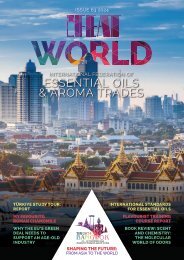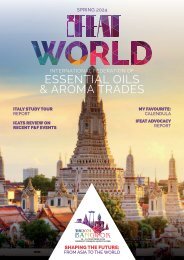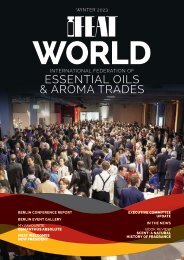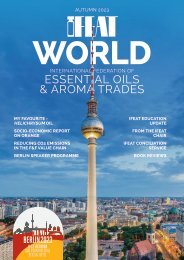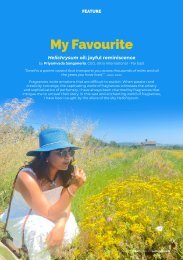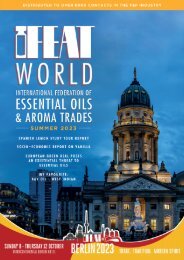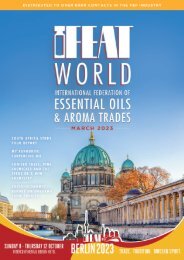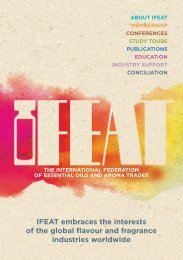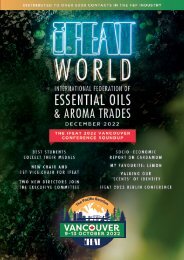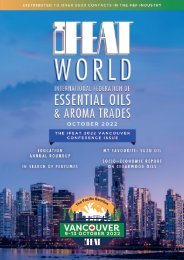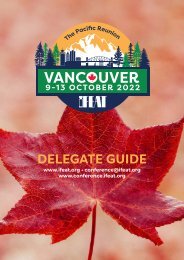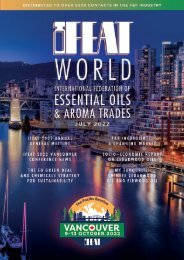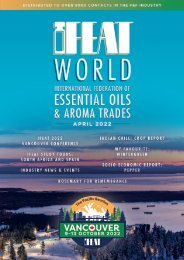IFEATWORLD June 2017
Create successful ePaper yourself
Turn your PDF publications into a flip-book with our unique Google optimized e-Paper software.
WORLD 9<br />
IFEAT/IFRA SOCIO-ECONOMIC<br />
IMPACT STUDY OF THE “NATURALS”<br />
FRANKINCENSE<br />
Both frankincense and myrrh (F & M)<br />
grow as small trees or shrubs; they are<br />
of the botanical family Burseraceae.<br />
Frankincense (also called olibanum) is<br />
classified as belonging to the Boswellia<br />
genus, while myrrh is obtained from<br />
trees of the Commiphora species. The<br />
nomenclature of these products is both<br />
complex and confusing. Thus, there are<br />
numerous species and varieties of F & M<br />
trees, each producing a slightly different<br />
type of resin. Differences in soil and climate<br />
create even more diversity of the resin,<br />
even within the same species. The primary<br />
species relied upon today are Boswellia<br />
carterii (Somalia) and Boswellia papyrifera<br />
(Ethiopia) for frankincense and Commiphora<br />
myrrhae for myrrh. Pappas (2016) argues<br />
that frankincense should also be classified<br />
by chemotype as well as species, and<br />
discusses the five main chemotypes that<br />
encompass the five main species.<br />
IMPACT CATEGORY:<br />
High impact, many people involved.<br />
Political instability, combined with<br />
geographic isolation and the nomadic<br />
nature of much of the collection area,<br />
makes it almost impossible to get accurate<br />
data. According to Farah (1994),<br />
officials of the Frankincense and<br />
Gums Development and Sales<br />
Agency reasonably estimated<br />
that the number of families in<br />
northern Somalia alone that<br />
primarily depend upon incense<br />
gathering is around 10,000<br />
and the occurrence of commercial<br />
frankincense, “is absolutely crucial to<br />
the subsistence of a large number of the<br />
regional population”.<br />
AND<br />
MYRRH<br />
the financing of significant events such as<br />
weddings, funerals or for the purchase<br />
of food stocks.”<br />
RELEVANT SITE<br />
LOCATION:<br />
F & M are tree resins produced in East<br />
Africa, particularly Ethiopia, Somalia,<br />
Somaliland and Puntland, the southern<br />
Arabian Peninsula, particularly Yemen and<br />
Oman, and the Sahelian region of Africa.<br />
Other producing countries include Sudan,<br />
Kenya, Chad, Central African Republic,<br />
Cameroon and Uganda. The trees are<br />
found in very exposed and arid or semi-arid<br />
regions with poor organic soil composition.<br />
FARMED OR FORAGED:<br />
Foraged. Most resin (whether F or M) is<br />
obtained either by collecting the exudate<br />
or more commonly by the tapping<br />
of wild growing trees. Tapping<br />
BOSWELLIA TREE<br />
involves making deliberate incisions into<br />
the bark of the tree. The resin is left to<br />
exude from the tree and harden for a few<br />
days. The collector then returns to collect<br />
the hardened gum and re-mark the tree for<br />
more gum to start exuding. Resins are usually<br />
collected every 10 to 15 days.<br />
F & M is predominantly a traditional trade<br />
undertaken by nomadic communities<br />
and networks that has been in existence<br />
for thousands of years. Tapping is done<br />
by traditional means by indigenous<br />
communities, including local farmers and<br />
villagers, with nomadic traditions and is<br />
often undertaken alongside other activities,<br />
including herding. Collection is, at times,<br />
carried out by pastoralist peasants who<br />
include poor members of the community,<br />
women and/or children, as they collect<br />
water and wood fuel or tend small stock, or<br />
by organised tappers/collectors. It is not an<br />
organised or agricultural type of harvesting,<br />
but rather a wild craft method.<br />
IFEAT/IFRA SOCIO-ECONOMIC IMPACT STUDY OF THE “NATURALS” • FRANKINCENSE AND MYRRH<br />
More recently, in 2013, Zahra Osman of<br />
Neo Botanika (Somaliland) stated that, “For<br />
many villagers, the collection of gum often<br />
represents their only opportunity to earn<br />
cash and this is particularly important for




